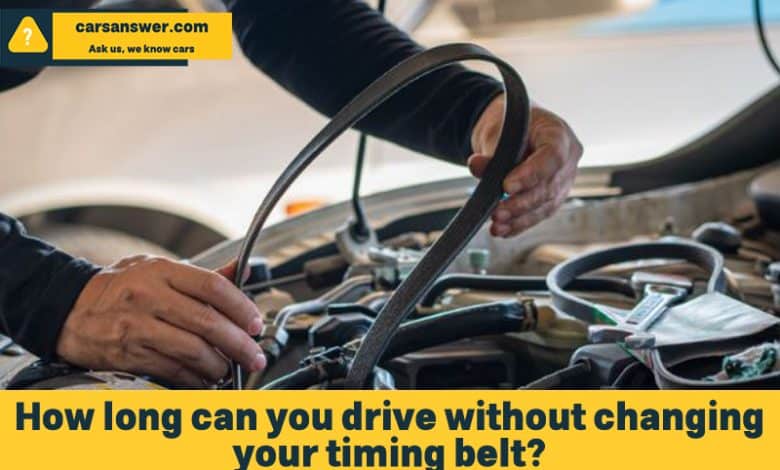How long can you drive without changing your timing belt?

A timing belt is an essential component of a car’s engine, responsible for synchronizing the rotation of the crankshaft and camshaft. This synchronization ensures that the engine’s valves open and close at the right time, which is crucial for efficient engine performance. The timing belt is made of rubber and reinforced with nylon cords, and over time, the rubber can wear, crack or deteriorate, causing the timing belt to fail. In this article, we will explore in detail how long a driver can drive without changing their timing belt, the factors that affect its lifespan, and the signs of wear that indicate the need for replacement.

How long do timing belts last?
The lifespan of a timing belt depends on several factors, including its material, quality, and manufacturer’s recommendations. Generally, a timing belt lasts anywhere between 60,000 to 100,000 miles, but some timing belts may last up to 150,000 miles, while others may fail before reaching 60,000 miles.
The material of the timing belt plays a vital role in determining its lifespan. Most timing belts are made of rubber with nylon cords, while others use materials such as kevlar or fiberglass, which offer better durability and longer life. The quality of the timing belt also determines its durability. Timing belts from reputable manufacturers with a proven track record of quality are more likely to last longer than those from lesser-known brands.
The manufacturer’s recommendations for timing belt replacement are also important. Mostmanufacturers provide recommendations on when to replace the timing belt, usually based on the age and mileage of the vehicle, as well as the driving conditions. These recommendations can vary widely, with some manufacturers suggesting replacement at 60,000 miles, while others may recommend replacement at 100,000 miles or more. It’s essential to follow the manufacturer’s recommendations to ensure the proper maintenance of the vehicle.
Factors affecting the lifespan of a timing belt
Several factors can affect the lifespan of a timing belt. These include age, driving conditions, engine type, and manufacturer’s recommendations.
Age: Even if a timing belt has not covered many miles, it can still degrade over time due to exposure to heat, oil, and other contaminants. A timing belt that is more than six years old, regardless of mileage, should be replaced.
Driving conditions: Vehicles that are driven in hot and humid conditions or dusty environments may experience more wear and tear on their timing belts. High ambient temperatures can accelerate the degradation of rubber, while dusty environments can cause abrasion and damage to the belt.
Engine type: Some engines are more prone to timing belt failure than others. Interference engines, for example, have little clearance between the valves and the pistons. If the timing belt breaks, the pistons can collide with the valves, causing significant engine damage. Non-interference engines, on the other hand, have sufficient clearance, and if the timing belt breaks, the engine will stop but without causing any damage.
Manufacturer recommendations: Manufacturers provide recommendations on when to replace the timing belt. These recommendations are usually based on the age and mileage of the vehicle, as well as the driving conditions. It’s essential to follow the manufacturer’s recommendations to ensure the proper maintenance of the vehicle.

Signs of timing belt wear
It’s crucial to keep an eye out for signs of timing belt wear to prevent engine damage. Here are some signs that your timing belt may need to be replaced:
Engine misfires: If the timing belt has stretched or skipped a tooth, the engine’s timing can be off, causing misfires. Misfires can occur when the fuel and air mixture in the combustion chamber does not ignite properly.
Ticking or clicking noises: If you hear unusual ticking or clicking noises coming from the engine, it could be a sign that the timing belt is worn. These noises can occur when the timing belt rubs against other engine components.
Oil leaks: If oil is leaking from the timing belt cover, it could be a sign that the timing belt is worn and needs to be replaced. Oil leaks can occur when the timing belt cover becomes warped or damaged due to age or wear.
Difficulty starting the engine: A worn timing belt can cause the engine to turn over slowly or not start at all. This is because a worn timing belt can cause the engine’s timing to be off, preventing the engine from starting.
Engine shaking: If the engineis shaking or vibrating, it could be a sign that the timing belt is worn and needs to be replaced. Engine shaking can occur when the timing belt skips teeth or is stretched, causing the engine to run unevenly.
Importance of regular maintenance
Regular maintenance can help prolong the life of the timing belt and prevent engine damage. It’s essential to follow the manufacturer’s recommendations for when to replace the timing belt. Additionally, routine inspections of the timing belt can help detect signs of wear before they become a problem. A mechanic can inspect the timing belt and check for cracks, fraying, or signs of oil contamination. Regular oil changes can also help keep the timing belt in good condition by reducing the risk of oil contamination.
It’s important to address signs of timing belt wear promptly to avoid costly repairs. If the timing belt fails, it can cause significant engine damage, which can be expensive to repair. Replacing the timing belt is a relatively inexpensive maintenance item that can save you money in the long run.
Additionally, it’s crucial to replace the timing belt as part of regular maintenance rather than waiting for it to fail. If the timing belt fails, it can cause significant engine damage that can be avoided with proper maintenance. Replacing the timing belt can also improve engine performance and fuel efficiency.
Conclusion
In summary, the lifespan of a timing belt depends on several factors, including its material, quality, and manufacturer’s recommendations. Regular maintenance, including following the manufacturer’s recommendations and routine inspections, can help prolong the life of the timing belt and prevent engine damage. Signs of timing belt wear include engine misfires, ticking or clicking noises, oil leaks, difficulty starting the engine, and engine shaking. Age, driving conditions, engine type, and manufacturer’s recommendations are the key factors that affect the lifespan of the timing belt. It’s essential to address signs of timing belt wear promptly to avoid costly repairs. Replacing the timing belt as part of regular maintenance can save you money in the long run and improve engine performance and fuel efficiency. Ultimately, understanding the lifespan of a timing belt and its signs of wear is essential for responsible vehicle ownership and protecting your investment.





